|
|
On the edge of nowhere . . . ?
|
|
Posted by Marc
from Garden Desk
My garden has no tomato plants in it right now. It is Fall in my garden and I am growing lots of broccoli, cabbage and lettuce in the space where tomatoes grew during Summer. Now that time in the garden is getting shorter, I can begin planning for next season. It is time for me to reflect on how things went this year in the vegetable garden, and figure out ways to improve next year's garden.
The main thing I like to experiment with in my garden is tomatoes. I'm always looking for different kinds of tomatoes, different color tomatoes, and different heirloom tomatoes. This year, I raised over 30 different kinds of tomatoes and had at least two plants of each kind. The biggest problem I had was that I never managed to put any support on some of my tomato plants.
If you don't stake or tie up your plants, it can get pretty messy.

The biggest problem with not supporting the plants is that the fruits lay on the ground. There they are more susceptible to animals and are prone to rot.
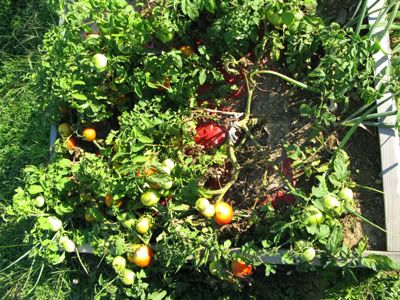
So if the above pictures show what not to do, what is the best way to support tomatoes?
Many people tie each plant to a stake. Others use store-bought cages, but they tend to fall over on me after my plants reach about five feet tall. How to support tomato plants is another thing I have experimented with a great deal and my favorite three methods are; Topless Tables, A tomato tower trellis, and the Florida Stake and Weave.
1. Topless Tables
Several years ago when I still tried to use store-bought tomato cages, I grew more plants than I had cages for. My solution was to build tomato cages out of scrap wood. To me they looked more like tables without a top, so my family began calling them "topless tables". Here is one compared to the regular cages:
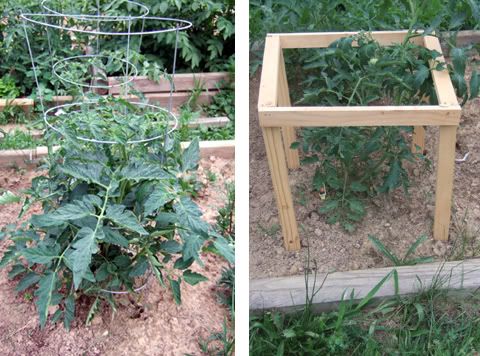
These don't look pretty, but they keep the tomatoes off the ground without any pruning, staking or tying. The tomato plant grows through the middle and the branches sprawl over the sides. I have experimented with making double-decker tomato tables, but I don't think it is necessary.
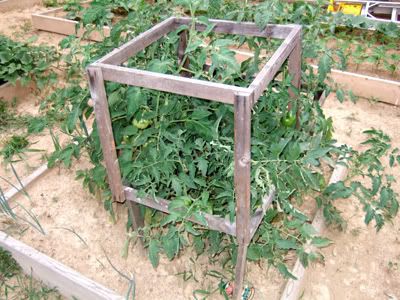
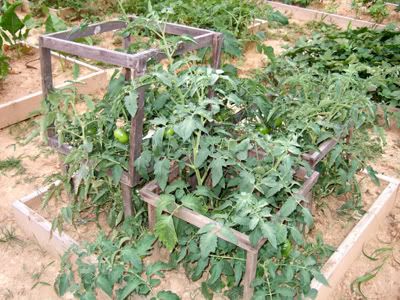
2. Tomato Tower Trellis.
At least one of my raised beds occupies our grand tomato trellis each year.
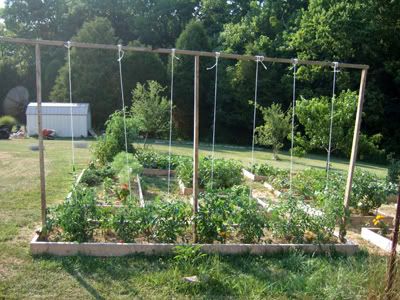
It is basically a very tall trellis in which you tie twine or clothesline from the top and then loop the other end around the base of the plant (you do not tie it to the plant). You then wind the twine around the central stem as the tomato plant grows.
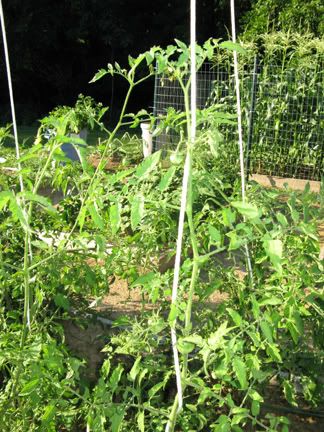
This keeps the plant growing straight and upright. It works best if you keep the suckers pruned off of the central stem. I have used this method for years, but you can only support a limited number of plants this way. This year, instead of placing the tomato plants directly under the trellis frame, I put the trellis in the center of two rows of plants and made the twine go from a plant on one side, over the top, and to a plant on the other side. This doubled production of the trellis, but looked a bit confusing.
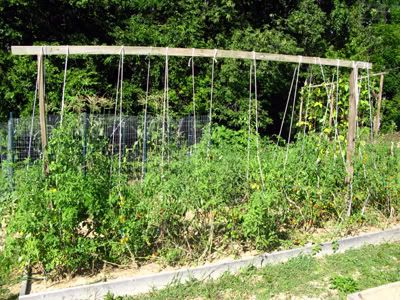

3. Stake and Weave
The Florida Stake and Weave gets its name from the practice that Florida commercial tomato farmers developed many years ago. It works well in the backyard garden too.
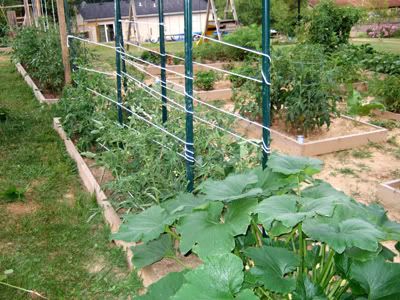

You put stakes in between each plant or every few plants depending on how closely spaced you tomatoes are. You then tie twine or clothesline from post to post, weaving in and out of the tomato plants. With subsequent twines above one another weaving the opposite direction, you can easily "suspend" your tomato plants.
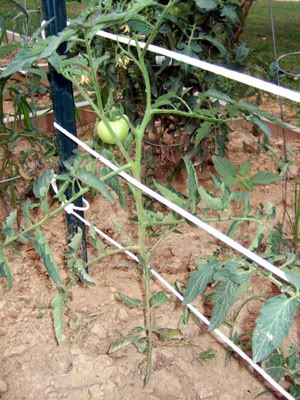
My improvement this year was to use 2x4s as the stakes and instead of tying the twine to each post, I drilled a hole in the stake for the twine to go through. I still weaved the plants in the same way, but these stakes made the system look much cleaner.


So what about you? How do you support your tomatoes? Stakes or cages? Stake and Weave or some other system? Do you tie them up or use a trellis? Do you have your own creative way of keeping those tomatoes off the ground? I am always looking for a new idea to try and I'd love to know your thoughts here.
Thanks and Happy Tomato Picking!
Keep Growing,
- Marc
| Symptom | Cold | H1N1 Flu |
| Fever | Fever is rare with a cold. | Fever is usually present with the flu in up to 80% of all flu cases. A temperature of 100°F or higher for 3 to 4 days is associated with the H1N1 flu. |
| Coughing | A hacking, productive (mucus- producing) cough is often present with a cold. | A non-productive (non-mucus producing) cough is usually present with the H1N1 flu (sometimes referred to as dry cough). |
| Aches | Slight body aches and pains can be part of a cold. | Severe aches and pains are common with the H1N1 flu. |
| Stuffy Nose | Stuffy nose is commonly present with a cold and typically resolves spontaneously within a week. | Stuffy nose is not commonly present with the H1N1 flu. |
| Chills | Chills are uncommon with a cold. | 60% of people who have the H1N1 flu experience chills. |
| Tiredness | Tiredness is fairly mild with a cold. | Tiredness is moderate to severe with the H1N1 flu. |
| Sneezing | Sneezing is commonly present with a cold. | Sneezing is not common with the H1N1 flu. |
| Sudden Symptoms | Cold symptoms tend to develop over a few days. | The H1N1 flu has a rapid onset within 3-6 hours. The flu hits hard and includes sudden symptoms like high fever, aches and pains. |
| Headache | A headache is fairly uncommon with a cold. | A headache is very common with the H1N1 flu, present in 80% of flu cases. |
| Sore Throat | Sore throat is commonly present with a cold. | Sore throat is not commonly present with the H1N1 flu. |
| Chest Discomfort | Chest discomfort is mild to moderate with a cold. | Chest discomfort is often severe with the H1N1 flu. |